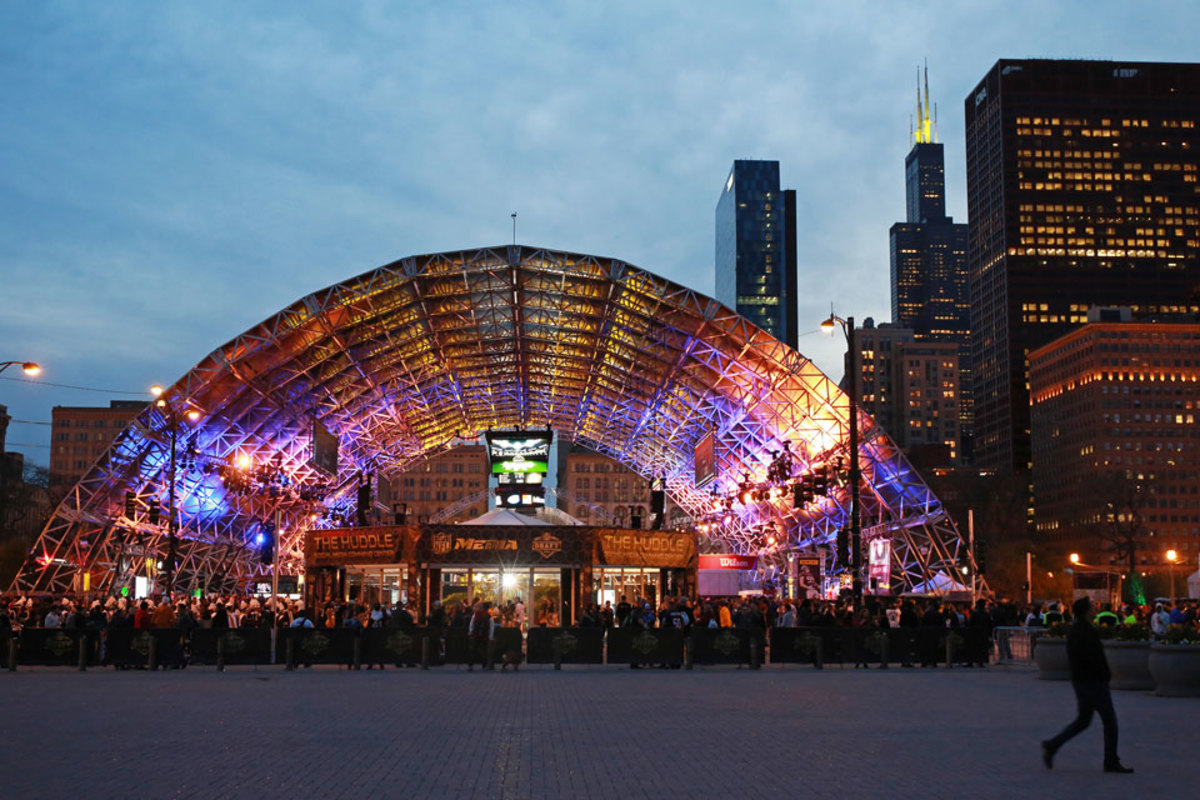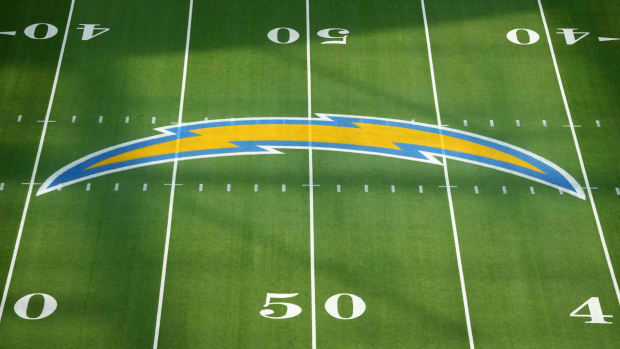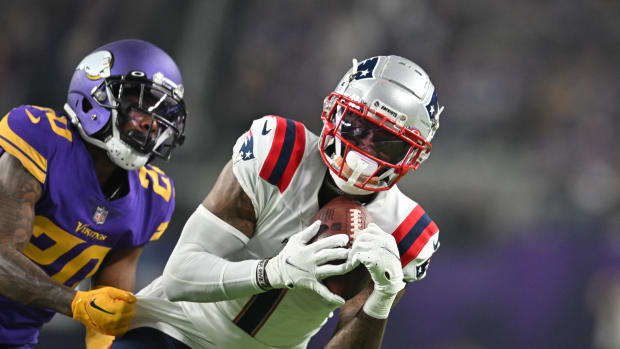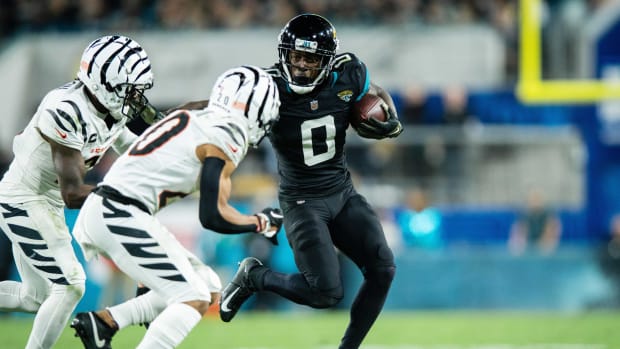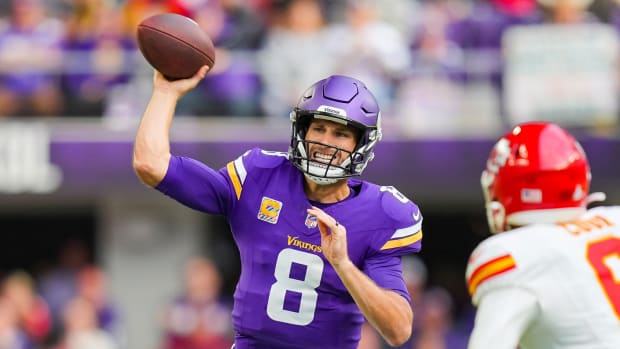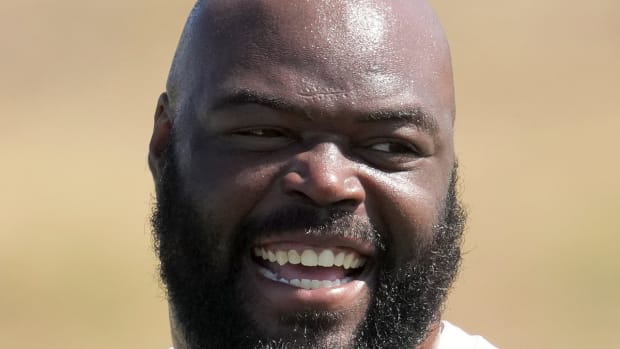The Future of the Draft
By Kalyn Kahler
CHICAGO — As the draft wound down 17 days ago, the NFL’s vice president of special events, Peter O’Reilly, took stock of this year’s unique venue. After opening at the Auditorium Theatre, the festivities moved outside for rounds three through seven, and more than 200,000 fans showed up to Grant Park to be a part of a draft that was held somewhere other than New York City for the first time since 1964.
“It’s going to be very difficult to go back to a theater-only environment and not have the broader fan experience,” said O’Reilly, speaking beneath the Draft Town arch at the park’s entrance.
The day before the draft, Roger Goodell spoke to students at Northwestern University and joked (or so it seemed) about holding the draft thusly: “Seven rounds, seven days, seven states.” That would be a logistical nightmare, and a classic case of killing the golden goose, but 2015 showed that the NFL draft is no longer just a TV show.
“In early meetings we said having 10,000 fans in the park would be nice,” O’Reilly said. “We hit that by many multiples. Our wildest dreams and expectations were absolutely blown away.
“We have seen the power of bringing it to a new market and connecting with new fans and allowing them to experience it. We’ve got to strike that balance between, ‘This is a great home for the draft and we’ve got a model that works well,’ and balance that with, ‘Where are there other opportunities? What markets are interested?’ ”
Watching the Draft Through Agentsu2019 Eyes
The waiting, the worrying, the counseling, the celebrating. A startup group gave The MMQB a behind-the-scenes look at an agent’s wildest ride: draft week. FULL STORY
Just what is in store for the future of the NFL draft?
Chicago was chosen this year after winning a close race with Los Angeles, which is becoming a focal point for future NFL interests. Patriots owner Robert Kraft wants the draft in the Boston area; Cowboys owner Jerry Jones wants it in Dallas. Other owners surely will step forward, having seen the draft as a three-day commercial and tourist attraction for Chicago.
The draft could turn into a traveling road show and be held in a different market every year. Or, like the Super Bowl, it could rotate among a select group of cities. Whatever happens, the days of the draft being held solely within the confines of Radio City Music Hall seem to be all but over. That doesn’t mean the draft has forever left New York; there would just need to be some grass nearby, and room for moms and dads and kids in strollers. “The draft should move around,” said Bears season-ticket holder Terrence Moore, who attended his first draft this year. “It’ll give more access to the fans and that’s only going to make more fans for the league.”
“It’s going to be a good thing to spread it around and get a new feeling for each draft,” another fan, Chris Pinto, said, “because each city really now gets to showcase themselves and make their draft experience better than the other cities.”
From the oversized team helmets placed in Pioneer Park to the buildings along the city’s skyline lit up to spell out “Draft Town,” Chicago owned its chance to play host city.
“The Chicago format was so different than New York and so much broader,” O’Reilly said. “In New York, when we went to the two nights in prime time and the three-day format, that was a big shift. That took the draft to the next level, and now this feels like that next major shift.”
Collins: How It All Went Down
A first-round talent out of LSU, La’el Collins became radioactive just days before the NFL draft when his name was linked to a double homicide in Baton Rouge. Robert Klemko tells the inside story of how Collins' agents tried to salvage his stock, and the winding journey that put him across the table from police detectives and Jerry Jones. FULL STORY
For the first time in draft history, the action on Day 3 took place exclusively outdoors, with each team announcing their picks via video feeds from across the country. It was hardly the yawn-fest of years past. In Jacksonville, a fan was thrown into the pool by the Jaguars mascot at Everbank Stadium after he announced Louisville safety James Sample as the team’s fourth-round pick. In Minneapolis, the foreman for the Vikings' new stadium project announced Minnesota's fourth-round pick, Pittsburgh tackle T.J. Clemmings, from the construction site.
“Reimagining Day 3 was a big part of it. We are taking ‘Draft Town’ on Saturday and making it ‘Draft Nation,’ ” O’Reilly said. “Making it feel that much bigger.”
Chicago’s central location—it’s 500 miles from 11 NFL markets—was, as O’Reilly put it, “the determining factor” for moving the draft to the Windy City. Reflecting on his project, O’Reilly said the only change he would make is expanding the fan festival.
“I probably would have expanded the footprint earlier and gone even bigger, because Chicago fans overdelivered in terms of their passion,” he said.
Back in his Park Avenue office, O’Reilly is busy breaking down every aspect of the event and reviewing the feedback from fans and clubs. “We certainly have to look at the success of Chicago when making the decision,” he said of picking the 2016 draft site. “We don’t think it is going to be an instantaneous decision.”
But if it were up to Chicago Bears chairman George McCaskey, the decision would already have been made: “Let’s do it again here next year.”
Follow The MMQB on Facebook, Twitter and Instagram.
[widget widget_name="SI Newsletter Widget”]
































